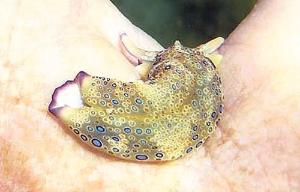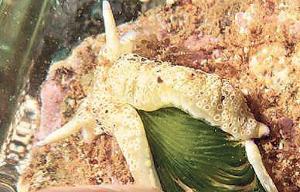Published in the Ocean Watch column, Honolulu Star-Advertiser © Susan Scott
May 21, 2012

A sap-sucking sea slug.
One of the things I love about marine biology is discovering how little I know. Really. After spending the last 30 years seeking out, swimming with and reading and writing books about marine animals, I am still learning things that blow me out of the water. Take, for instance, the ringed sap-sucking sea slug.
Every time I go snorkeling in one spot on the North Shore, I see these 2-inch-long animals littered on the sea floor in shallow water. Because these sea slugs are numerous, sand-colored and often partially or fully covered with sand, I mostly ignored them.
Last week, though, I picked one up and took its picture as it clung to my palm. Enlarging the photo gave me a pleasant surprise. Lovely blue spots dotted the creature’s body, and the animal’s frilly rear and its hornlike tentacles up front, called rhinophores, were lined in lavender.
The animal’s beauty was a revelation, but that was small compared with its lifestyle. These creatures are solar-powered, able to live for months on light alone.
This sea slug is one of several hundred species, mostly in the tropical Pacific, called sap-suckers. The animals eat green seaweed by piercing the plant’s cells with a sharp, pointed tooth and then sucking out the juices, or sap, including bodies called chloroplasts.
Chloroplasts are the magic factories that make sugars from sunlight. The sap-sucker stores its ingested, living chloroplasts in tissues on its back, and when the sun shines, the chloroplasts make carbs. If the slug can find fresh veggies, it grazes on them, but when seaweed is scarce, the slug grows its own. It’s like carrying your own broccoli garden on your shoulders.
The odd feature of this farming is that sap-suckers have two overlapping flaps on their backs that cover the chloroplasts. The purpose of this is unknown. One researcher suggests that the flaps regulate the amount of sunlight hitting the chloroplasts and thus control production.
I read that if I gently spread the creatures’ back flaps, I could see the sap-sucker’s green garden.

Back to the beach with my camera. Sure enough, as I carefully examined the backs of several subjects, I found their bright patches of produce.
I also found in my searches some excellent websites. For everything you wanted to know about sea slugs, and pictures to marvel over, check out seaslugsofhawaii.com and www.seaslugforum.net.
Those little sap-suckers sure made my day. Imagine the fun I’m going to have when I get a mask with corrective lenses.

© Susan Scott